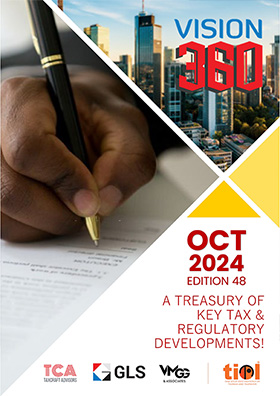IT - Whether when assessee has made investment, but quantum was less in comparison of its own funds, in such case, to that extent disallowance u/s 14A cannot be warranted on account of interest expenditure - YES: ITAT
By TIOL News Service
BANGALORE, OCT 17, 2016: THE issue is - Whether in case there is an increase in the investment, however the corresponding increase in the assessee's own fund is much more than the amount of investment made, in such a case, to that extent disallowance u/s 14A cannot be warranted on account of interest expenditure. The Tribunal answered in affirmative.
Facts of the case
The assessee is a company. For the AY 2007-08, CIT (A) has deleted disallowance on the ground that the borrowed fund had been utilized by assessee for the business purpose and therefore the assessee had not used the borrowed fund for the purpose of investment in question. CIT (A) had also relied upon the order passed on the investment issue of disallowance u/s 14A for the AY 2006-07. There was no fresh investment during the assessment year under consideration except Rs.50,000. Therefore the issue of disallowance u/s 14A on account of interest expenditure was dependent on the finding on this issue for AY 2006-07. The Tribunal in assessee's own case for the AY 2006-07 had remitted this issue in ITA Nos.84 & 85/Bang/2014 vide order dt.24.11.2014 2015-TIOL-892-ITAT-BANG. There was no quarrel on the point that Rule 8D was applicable only from AY 2008-09 onwards and therefore the same was not retrospective and not applicable for the year under consideration. Hence in view of the order of this Tribunal for the AY 2007-08, the issue of disallowance u/s 14A was set aside to the record of AO with the similar direction. As regards the disallowance on account of administrative expenses the AO had to consider the objections of the assessee in the light of decision of Delhi HC in the case of Cheminvest Ltd. Vs. CIT. For the AYs 2008-09 & 2009-10, Rule 8D was applicable and therefore the question arises whether for the AY 2008- 09 when the assessee had not received any dividend income the disallowance on account of interest expenditure can be made u/s 14A r.w. Rule 8D. It was pertinent to note that the issue was more of factual in nature and if it was found that the interest bearing fund had been used by the assessee for the purpose of investment in the share then the interest expenditure on such borrowed fund was otherwise not allowable u/s 36(1)(iii) as well as 37 being not laid out wholly and exclusively for the purpose of business of the assessee. Even otherwise when there was no dividend income the said interest expenditure was also not allowable u/s 57 as the purpose of taking the loan was not claimed by the assessee for the investment in shares.
Disallowance of claim of depreciation on goodwill as well as valuation of goodwill
Assessee was in the business of production and sale of Beer. During the previous year relevant to AY under consideration, the assessee's subsidiaries namely Karnataka Breweries & Distillery Ltd. (KBDL), London Draft Pubs Pvt. Ltd. (LDPPL) and London Pillsner Breweries Pvt. Ltd. (LPBPL) were amalgamated with the assessee. The assessee claimed depreciation of Rs.15,57,54,392 on goodwill of Rs.62,30,17,566. Thus goodwill was shown as a result of merger / amalgamation of KBDL. Therefore this dispute was confined only with respect to the valuation of the assets recorded by the assessee in its books post amalgamation which were taken from KBDL. AO asked the assessee to explain how this goodwill was added to the fixed assets. It was explained that goodwill arose on account of acquiring KBDL for a purchase consideration exceeding fair value of tangible assets and other net current assets from that company. KBDL became a wholly owned subsidiary of the assessee in the preceding year by virtue of acquisition of shares of the said company from shareholders for a consideration of Rs.180.52 Crores. During the year KBDL got amalgamated with the assessee as per the order of HC. Consequently all assets and liabilities as on 1.4.2006 were taken over into account for the tax purpose by the assessee. The assessee explained before the AO that while entering the tangible assets in its books the FMV as on that date one entered. The assessee had also produced the valuation report of the valuer who had computed the FMV of the tangible assets on the basis of replacement method and after reducing the depreciation from the replacement price, the FMV had been arrived by the valuer Sri A. V. Sethi & Associates. Thus the difference between the fair value and consideration was shown as goodwill. AO did not accepted the contention of assessee and observed that instead of fair value of asset based on the replacement value of the asset adopted in the valuation report the Fair Market Value (FMV) of assets should have been adopted in the books of accounts and consequently the valuation of the goodwill would be reduced by Rs.24.48 Crores. AO had also observed that on the land valuation, the valuer had adopted the guidance rate without considering the sale incidents of comparable land. Thus AO observed that if the replacement of cost of building, plant and machinery and higher value of land was taken to the books, there would not be any goodwill. AO concluded that differential amount being shown as goodwill cannot be considered as amount paid for brewing license as the assessee had not got the valuation of the license. Accordingly, AO had disallowed the depreciation on the goodwill on the ground that there was no goodwill if proper valuation was assigned to the tangible asset and land. On appeal, CIT(A) has concurred with the decision of AO by considering the fact that the value of the goodwill in the books of the KBDL was only Rs.7.45 Crores which had been shown by the assessee at Rs.62.30 Crores. CIT(A) held that there was no justification for adopting the balance figure of excess consideration over the net asset without admitting to support the said valuation.
Having heard the matter, the Tribunal held that,
Disallowance u/s 14A read with rule 8D
++ as regards the original investment which was made in the earlier year the issue is common for AY 2006-07 and therefore to that extent it is remitted to the record of AO to verify and decide as per the directions of the Tribunal. As it is apparent from the details that for AY 2008-09, there is a fresh investment of Rs.45 Crores whereas there is an increase in the assessee's own fund of more than about Rs.45 Crores. Similarly, for the A.Y. 2009- 10, there is increase in the investment of Rs.90 Crores whereas there is an increase in the assessee's own fund of about Rs.400 Crores. Therefore for these two assessment years though there is an increase in the investment as the assessee made fresh investment however the corresponding increase in the assessee's own fund is much more than the amount of investment made during these two AYs. Accordingly, we are of the view that so far as fresh investment is concerned the assessee’s own fund is more than sufficient to cover them and therefore to that extent no disallowance is called for u/s 14A on account of interest expenditure. As regards the old investment which was made prior to the AY 2007-08, the issue has a direct bearing of the finding and final outcome on this issue for the Assessment Year 2006-07. Since the said issue is also set aside to the record of the AO therefore the issue of disallowance of interest expenditure u/s 14A to the extent of old investment is set aside to the record of the AO with same direction as given for the AY 2006-07. Since there is a dividend income for the AY 2009-10 therefore the decision of Delhi HC in the case of Cheminvest Ltd. Vs. CIT was not applicable for the AY 2008-09 regarding disallowance of administrative expenditure being 0.5% of the average investment. AR of the assessee has submitted that the investment for the purpose of disallowance of administrative expenditure should be considered only on which the assessee has earned dividend from mutual funds. Thus AR has submitted that only Rs.90 Crores and Rs.2,58,000 can be considered as investment for the purpose of disallowance as per Rule 8D(2)(iii). Accordingly, we direct the AO to recompute the disallowance as per Rule 8D(2)(iii) by considering the investment in mutual funds which has yielded dividend income;
Disallowance of claim of depreciation on goodwill as well as valuation of goodwill
++ since there is an amalgamation of the subsidiary with the assessee therefore all the assets which came to the assessee are already in use by the subsidiary and consequently the valuation of all the assets are subjected to the verification of the AO as per Expl.3 of Section 43(1). However, AO chose to examine the valuation of goodwill alone in order to disallow the claim of depreciation on the enhanced value of goodwill. We find that the AO has not adopted any prescribed or well accepted method for valuation or actual cost of the goodwill in the hands of the assessee but he has doubted the valuation of the tangible assets and was of the view that the assessee has deflated the valuation of the tangible assets by the method of cost of replacement instead of FMV. The scope and objective of the Expl.3 of Section 43(1) is to check the excess claim of depreciation by enhancing cost of assets acquired which were already in use by other person. Therefore in case of valuation of goodwill the AO ought to have examined the valuation of all the assets taken over by the assessee under the amalgamation and thereby to determine the actual cost to the assessee for the purpose of claim of depreciation. In this case there is no doubt that the value of the goodwill was shown in the books of the KBDL at Rs.7.45 Crores which has been enhanced in the books of accounts of assessee to Rs.62.30 Crores. The assessee has forcefully contended that the valuation of the goodwill is nothing but only the differential value between the consideration and FMV of the tangible assets. Thus AR has contended that AO cannot disturb the valuation of the goodwill when it is a differential amount between the consideration and the FMV of the tangible assets. If such claim of goodwill and depreciation is allowed then it would render the provisions of Expln. 3 to Section 43(1) redundant, otherwise in every case of transfer, succession or amalgamation the party would claim excessive depreciation by assigning arbitrary value to the goodwill. Therefore the entire assets taken over by the assessee under the amalgamation are subjected to the Expl.3 of Section 43(1) and if AO finds that the assessee has claimed excess claim of depreciation by enhancing the cost of goodwill then actual cost of goodwill can be determined only by considering the actual cost of the other assets so acquired under amalgamation;
Issue of claim of depreciation on the enhanced cost of goodwill
++ the business of the subsidiary was transferred to the assessee by way of amalgamation therefore it would not be regarded as transfer of asset for the purpose of capital gain. Hence the claim of depreciation on the assets acquired under the scheme of amalgamation is restricted only to the extent if such amalgamation has not taken place. AO has proceeded to hold the value of the goodwill as shown by the assessee is not justified. It is pertinent to note that once the claim of depreciation is restricted under the 5th proviso to section 32(1)(ii) then the valuation issue become irrelevant. The CIT (A) has also concurred with the view of AO regarding the applicability of the 5th proviso to Section 32(1) and held that it was also highlighted both in the assessment order and remand report that no depreciation on goodwill was claimed by KBDL before amalgamation. Therefore, as per the 5th proviso to Section 32(1)(ii), the assessee was not entitled to depreciation. It is not the case of the assessee that the subsidiary has claimed any depreciation of goodwill. Therefore by virtue of 5th proviso to Section 32(1), the depreciation on the hands of the assessee is allowable only to the extent if such succession has not taken place. Therefore the assessee being amalgamated company cannot claim or be allowed depreciation on the assets acquired in the scheme of amalgamation more than the depreciation is allowable to the amalgamating company. As regards the decision of SC in the case of CIT Vs. Smiff Securities Ltd. 2012-TIOL-53-SC-IT, the said ruling of SC is only on the point whether the goodwill falls in the category of intangible assets or any other business or commercial rights of similar nature as per the provisions of section 32(1). Therefore there is no quarrel on the issue that goodwill is eligible for depreciation. However the said judgment would not over-ride the provisions of 5th proviso to Section 32(1) which restricts the claim in the cases specified thereunder. The consideration paid by the assessee for acquiring the shareholding of the subsidiary in the earlier years is not relevant for the issue of depreciation on the assets taken under amalgamation and for the purpose of 5th proviso to Section 32(1). Accordingly, in view of the above facts and circumstances of the case as well as the above discussion, we hold that the claim of depreciation in the hands of the assessee is subjected to the 5th proviso to Section 32(1). Accordingly, this issue is decided against the assessee. In the result, the appeals are partly allowed.
(See 2016-TIOL-1783-ITAT-BANG)















